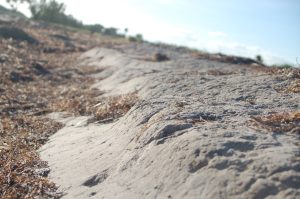Anyone that has ever put shovel to earth in South Florida knows that our “soil” is actually rock. The rock is a type of limestone known as Miami Limestone, or oolitic limestone, and is not coral as many people think. Limestone Gables didn’t quite have the right ring to it, so we stuck with Coral Gables, even though we knew better.
South Florida soils are a mixture of some sand, some marl (weathered limestone) and a lot of Miami Limestone which is alkaline with a pH of about 7.8 – 8.4. The limestone does not hold water or nutrients well. The high pH is the most troublesome characteristic of our soil because it makes it difficult or impossible for many of our plants to get some of the micro-elements they need. The high pH makes it necessary to apply micro-nutrients such as boron and zinc using a foliar spray or, in the case of iron, a chelated form that is mixed with water and poured over the plant’s roots. These fertilizing tricks help to get our plants what they need despite the high pH.

The fact that our soils do not hold water well actually turns out to be a good thing when we factor in the large amount of rain that falls in the summer months. High water holding capacity soils would undoubtedly result in massive flooding. Unfortunately, when soils do not hold water well, they usually do not hold nutrients well either. This makes it necessary to use slow-release fertilizers and as much mulch as possible so nutrients are not lost with every passing rainstorm. If you live in Miami-Dade County, make sure to read up on that county’s fertilizer ordinance.
Amendments
Mulch and compost are your best bet to battle our rocky soils. Mulch will not only beautify your landscape and help to discourage weeds, it will also slowly decompose to create an organic layer of soil in your garden. Compost helps as well, as it has already decomposed and can immediately begin to slowly feed your plants.
Planting
Amending a new planting hole with “good soil” is not recommended as this can create a container effect and keep your new planting’s roots from moving out into the native soil. When planting a new tree or shrub, dig the hole slightly bigger than the root ball and use the same soil you pull out of the hole. Planting the tree at the correct level is extremely important. Roots should be underground and the trunk should be above ground.
Plant Choice

Many species of plants are able to do quite well in our poor soil including tropical fruit such as mangos, sapodillas, and avocados. Other tropical fruit like lychees, longans, carambolas, and mameys have a harder time and benefit from a fertilizer program that includes foliar sprays of micro-elements and an iron drench at least twice a year during the rainy months.
Containers
When growing things in containers, you can control they type of soil you use. A good soil will drain well, hold nutrients, allow aeration in the root-zone and provide support for your plant. There are many ingredients that can be mixed in order to create a good potting mix. In order to get all four of the desired characteristics mentioned above, a good mix would have some sand, some peat, and some perlite depending on how aerated you would like the soil.
The best way to combat our poor soils is through plant choice. The right plant in the right plant is always the first step in choosing what you will grow. You can also help plants that have a hard time growing in our high pH with heavy mulching, composting, and supplemental applications of micro-elements through foliar sprays and drenches
 6
6
